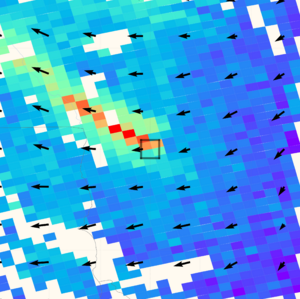Methane leak facts for kids
A methane leak is when a large amount of natural gas escapes from industrial sites or pipelines. These leaks are a type of methane emissions. Satellites can spot huge leaks, called super-emitter events, which create visible methane plumes. In 2022, over 1,000 such leaks were found worldwide.
Just like other gas leaks, methane leaks can be dangerous. For example, coalbed methane has always been a risk for miners. Methane leaks also harm our environment. Natural gas mostly contains methane, which is the main concern for both safety and the environment.
Methane is a powerful greenhouse gas. It's the second biggest cause of climate change, right after carbon dioxide. About 40% of human-made methane emissions come from finding, moving, and producing fossil fuels. Smaller leaks, too tiny for satellites to see, can be found by planes flying at about 900 meters (around 3,000 feet). Fatih Birol from the International Energy Agency says that cutting methane emissions is one of the cheapest ways to slow down global warming quickly.
Contents
Big Methane Leaks Around the World
Specific methane leaks are often reported as major events. They involve a huge amount of gas escaping.
Nord Stream Pipeline Incident
One example happened after the 2022 Nord Stream pipeline sabotage. Early reports suggested the leak might be over 100,000 tonnes. The International Methane Emissions Observatory (part of the United Nations Environment Programme) studied the leak. In February 2023, they estimated the methane gas released was between 75,000 and 230,000 tonnes. While this sounds like a lot, it was less than 0.1% of all human-made methane emissions for a year.
Super-Emitter Sites
Satellite data shows that the most super-emitter events from fossil fuel sites happen in Turkmenistan, the USA, and Russia. These leaks are usually caused by broken equipment. They can sometimes last for many weeks.
Aliso Canyon Gas Leak
The Aliso Canyon gas leak in 2015 released at least 109,000 tonnes of methane. This was one of the worst recorded leaks.
Other Major Leaks
In 2022, satellites showed a coal mine in Kemerovo Oblast, Russia, called Raspadskaya, was leaking methane at a rate of 87 tonnes per hour. This is a lot, especially when compared to the Aliso Canyon incident, which leaked about 60 tonnes of natural gas per hour.
A study in 2022 by Spain's Technical University of Valencia found a huge leak at an oil and gas platform in the Gulf of Mexico. It released about 40,000 tonnes of methane over 17 days in December 2021. That's about 98 tonnes per hour. Another big leak in August 2022 released 427 tonnes per hour near Turkmenistan's Caspian coast.
How We Measure Methane Leaks
When scientists talk about methane leaks, they use different ways to measure them.
Common Measurement Units
In the United States, people often use the standard cubic foot (scf) to measure natural gas. Because natural gas is a mix of gases, and its behavior changes with pressure and temperature, converting scf to metric units like tonnes can be tricky. One common conversion is 50,000 scf of natural gas equals about 1.32 short tons.
For detecting leaks, measurements are often given as standard cubic feet per hour (scf/h) or thousand standard cubic feet per day (Mscf/d). In metric units, they use kilograms per hour (kg/hr) or cubic meters per day (m3/d).
Measuring Methane in the Atmosphere
To understand how much methane is in the atmosphere, scientists use units like teragrams per year (Tg/yr). One teragram is equal to 1 million tonnes.
For example, satellite data from 2018-2019 estimated that the Permian Basin in North America, a major oil-producing area, leaked about 2.7 Tg of methane per year. This means about 3.7% of the gas taken out of the ground in that area was leaking. In 2021, a project called Carbon Mapper found 533 methane super-emitters in the Permian Basin alone.


